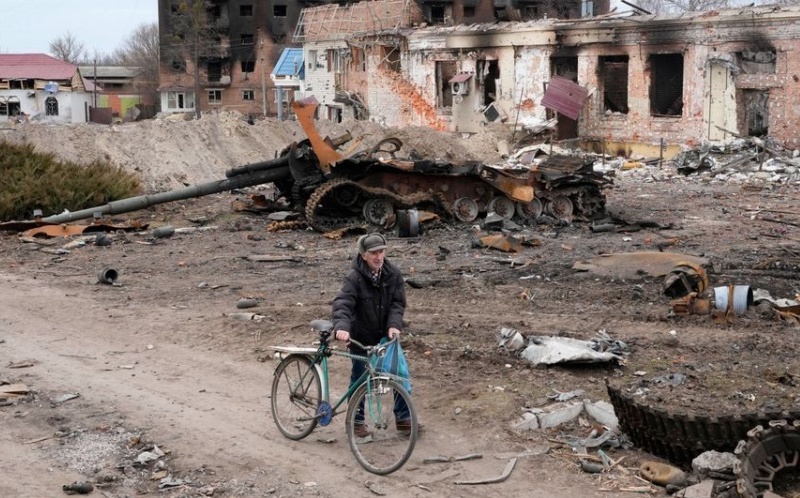A resident passes with his bicycle in front of damaged buildings and a tank in Trostsyanets, about 400km (250 miles) east of Kyiv, Ukraine, March 28, 2022 (Efrem Lukatsky/AP)
Christoph Reuter of Der Spiegel reports on possible war crimes by Russian troops as they occupied Trostyanets in eastern Ukraine, reclaimed by Ukrainian forces last weekend.
The spa town of about 20,000 residents was seized by the Russians on February 24, the first day of their invasion.
Reuter summarizes, “Aimless Russian invaders rapidly transformed into a murderous horde – one which increasingly, in the face of Ukrainian counterattacks, took out its fear and anger on the civilian population.”
A Ukrainian soldier explains that the Russians detained men at random. The occupiers looked through the men’s phones for photos of tanks and Russian positions and forced them to undress, looking for tattoos identifying them as part of the Ukrainian military. Anyone suspected of being an “enemy” was shot.
The troops destroyed the large chocolate and snack factory, owned by the US-based Mondelez International. Between 300 and 600 personnel occupied the police headquarters, the train station and the airstrip for small aircraft.
Running out of rations and attacked by Ukrainian drones, the Russians cut off the telephone network and electricity in early March, shutting down the pump for drinking water amid temperatures of -19C (-2F). They began looting of supermarkets and stores, stealing everything from televisions to second-hand clothing.
The crackdown escalated in early March. Smartphones were seized, and young men were taken to the interrogation center at the train station and beaten. A cyclist and a man running to the hospital — because his wife had gone into premature labor — were shot dead because they were on the streets after 3 p.m.. Alexander Vilinsky, 60, a veteran of the Soviet war in Afghanistan was killed when he refused to leave his home. A 31-year-old rail worker was shot through the heart by a sniper.
“They Didn’t Even Know Why They Were Here”
Residents said about 1/3 of the troops appeared to be militiamen from Russian-occupied South Ossetia in Georgia. Others came from the Russian-proxy areas of eastern Ukraine, or from the impoverished area of Buryatia in southeastern Siberia. Some were contract soldiers who only signed up four months ago.
A worker at the chocolate factory said he spoke with soldiers at the site: “They didn’t even know why they were here.” They said no one told them where they were heading next.
The troops asked, “Have we already made it to Kyiv? Is [Ukraine President Volodymyr] Zelenskiy still alive?” The worker said they wouldn’t like his answer: “Kyiv, Kharkiv, Odessa still belong to us! Zelenskiy is alive!”
The soldiers cursed and walked away.
The Ukrainian army closed on Trostyanets, moving into villages in surrounding forests. In late March, a drone and artillery attack destroyed three Russian tanks and a gun emplacement at the train station. The Russians responded with random fire on buildings. The city hospital was targeted by a tank which blew large holes in the top floor — fortunately, patients had been moved to the cellar.
As they withdrew, the Russians mined the chocolate museum, having already mined the botanical garden and its Nymph Grotto from 1809. They sprayed graffiti such as “Zelenskiy is a fag” or “For the honor of Russia.” They defecated room by room in offices and an auditorium and even on the body of a slain civilian.
A former assistant professor watched the depature:
Twelve tanks, 20 armored personnel carriers, three large howitzers, one multiple rocket launcher and 30 trucks. Behind them were 20 cars stolen from civilians with a red “Z” [the Russian symbol for the invasion] painted on them, many of them with fully packed luggage racks on the roof.

